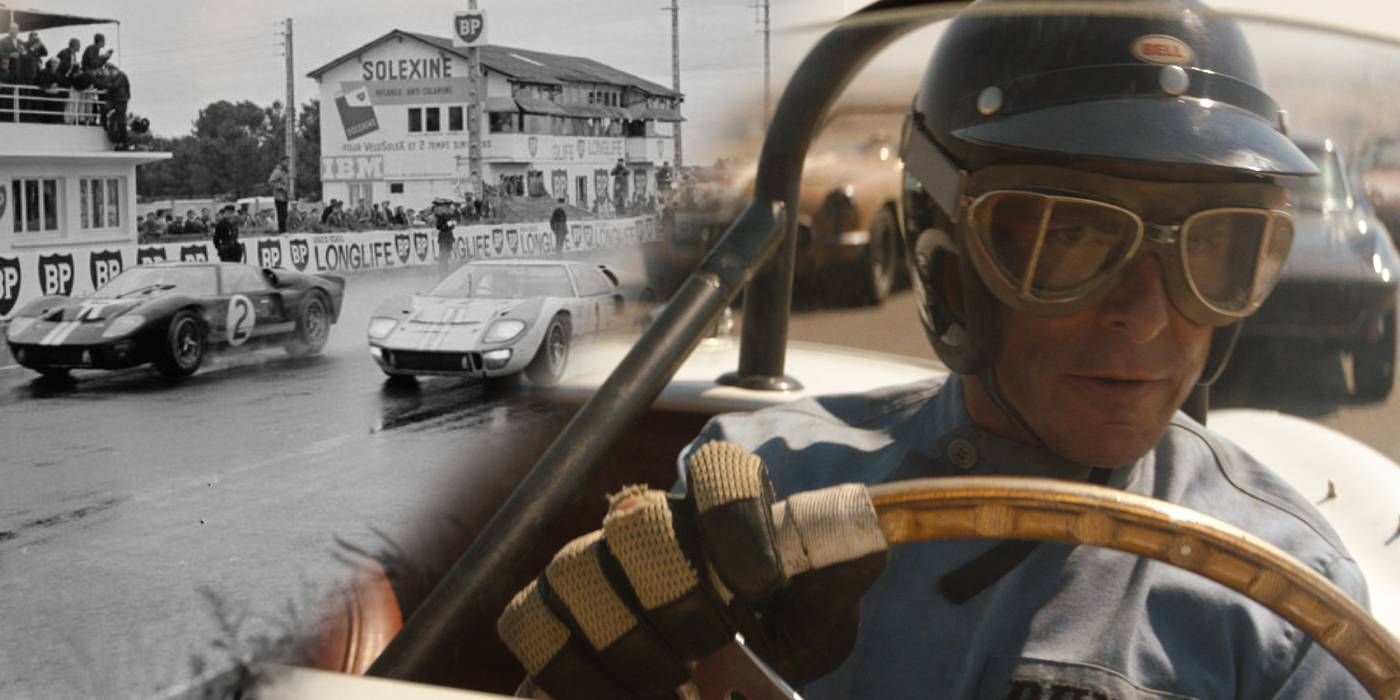Ford v. Ferrari True Story: 10 Biggest Details The Le Mans '66 Movie Leaves Out
Summary The movie Ford v Ferrari left out Ford's 1964 Le Mans race, showcasing just their 1965 and 1966 attempts.
While the film depicts a neck-and-neck race, Ferrari actually performed poorly in the 1966 Le Mans compared to Ford.
The conflict between Ford and Ken Miles in Ford v Ferrari was overblown; Ford had no problem with Miles driving.
Ford v Ferrari tells the incredible true story of the iconic car manufacturer's rivalry at the 1966 Le Mans race, but leaves out some notable details that could've had a place in the film. One of the better films to come from director James Mangold, the sports drama stars Matt Damon as Carroll Shelby, a famous American racecar builder, and Christian Bale as Ken Miles, a talented driver, who both lend their efforts to help Ford outpace Ferrari in the 24 hour Le Mans race. In the 60s, Ford and Ferrari had a bitter rivalry on both the racetrack and the boardroom.
To give credit where credit is due, Ford v Ferrari is one of the most accurate biopics made in recent years, making a painstaking effort to stay true to the real events of the automotive giants' feud. But like any film based on true events, some small liberties had to be taken in order to condense history into a satisfying 2-and-a-half hour narrative. Sadly, several important details of the true drama were lost in translation.
10 Ford V Ferrari Left Out An Entire Year of Le Mans
'65 and '66 weren't the only years Ford threw their hat in the ring
The film depicts Ford's earliest efforts at entering the prestigious Le Mans 24-hour race, a grueling endurance test that had previously been gatekept by elite European automotive manufacturers. Like any good sports drama, Ford v Ferrari has its underdog protagonists stumble once before overtaking their historic opponents, in the 1965 and 1966 Le Mans races, respectively. However, the film actually glosses over Ford's first year of racing at Le Mans in 1964.
Before 1965, Ford took a crack at the historic automotive marathon in 1964, with similarly poor results. It's understandable why the film cut out this repeat year of failure, being more or less a recap of Ford's shortcomings in the preceding year. That being said, some significant development occured over Ford's two Le Mans losses, which might've contributed to Ford v Ferrari's narrative.
9 Ferrari Did Much Worse In The 1966 Race
The real Le Mans wasn't so neck-and-neck
Like all the best car racing movies, the climax of Ford v Ferrari sports a neck-and-neck showdown between Ken Miles and his rival racer at Ferrari, Lorenzo Bandini against the dramatic sunrise of the Mulsanne Straight. The last leg of the film depicts a close duel for supremacy at dawn, with Miles able to barely out-maneuver his Italian opponents in the end, though he loses the race overall to a controversial ruling giving McLaren the trophy. In reality, the results of the '66 race were far less flattering for Ferrari.
In reality, the 1966 race saw the number 21 Ferrari car all the way back in 12th place by midday. In contrast, it was the number 3 Ford GT40, driven by fellow Americans Dan Gurney and Jerry Grant, that presented Miles' second-biggest competition on the track. The inter-Ford fighting would've been a dramatic inclusion for the film to make, as the pair made a break for Miles against orders, but not giving team Ferrari a fierce final showing in the film would've defeated the purpose of the very title.
8 Ford Had No Problem With Miles Driving In '66
The feud between the Ford's driver and their corporate suits was overblown
The conflict between Ford and Ferrari themselves wasn't the only conflict depicted in the film. Ford v Ferrari displays a fair amount of infighting between Ford's corporate leadership and the scrappy efforts of Carroll Shelby and driver Ken Miles in particular. Miles' brash personality, even for a racecar driver, is seen as a dangerous liability by the suits of the Blue Oval in the movie, making him nearly disqualified from racing in the 1966 Le Mans race. Shelby is able to get around this due to a brave bet on Miles' success in Daytona.
In reality, this gambit never occurred, and Ford didn't have so much of a problem with Miles. Not only was he given the green light to put the pedal to the metal in 1966, but he even raced for Ford in the 1965 Le Mans race, though he didn't finish due to technical issues revolving around his vehicle's transmission. The true story of Miles being more-or-less a shoo-in for Ford's roster in 1966 isn't as dramatic as the events portrayed in the movie.
7 The Technology Of The GT40 Was Overlooked
Somehow, Ford v Ferrari' understated the supercar's importance
The genius behind Ford's Le Mans success in 1966 and the subsequent decade, Carroll Shelby became an iconic name in motorsport for a good reason. Ford v Ferrari made his GT40 design one of the most iconic cars in film, echoing the real-world importance of the vehicle in Ford's legacy. Yet the film somehow understated just how revolutionary the design of Shelby's magnum opus was.
If the movie was to be believed, the legendary racecar was manufactured on an airfield with a box of scraps, playing up Shelby's ingenious nature and ability to jury-rig record-breaking cars with limited resources. In reality, the technology that went into creating the Ford GT40 was nothing less than cutting edge for the time, with the motor being put through simulations of the Le Mans race thanks to advanced engine dynamometers and the suspension being calibrated with the help of a primordial computer program. Ford truly spared no expense with the GT40's development.
6 Fiat Gave Ferrari A Generous Cash Stipend
The fellow Italian car manufacturer gave its competitor fair credit
Part of the corporate intrigue narrated by Ford v Ferrari includes a cloak-and-dagger corporate buyout of Ferrari by fellow Italian carmakers, Fiat. The movie describes this as a daring counterbid that took advantage of Ferrari and Ford's business negotiations, putting the iconic galloping horse under the employ of the manufacturer best known for producing sensible compact commuters like the Fiat 500. In reality, Fiat had much more admiration for their fellow Italian car company.
It is true that Ferrari eventually fell under Fiat's umbrella, but this wouldn't happen in real life until 1969, making the buyout anachronistic in its film appearance. Not only that, but in the year the event took place within the film, Fiat actually granted Ferrari a generous cash sum for the global elevation of Italian motorsport. Fiat's hand needed no such forcing to help invest in their compatriots's racing potential.
5 Ferrari Was The One To Suggest The Deal
It was Enzo himself that propositioned the merger
Ford v Ferrari more or less accurately displays the petty corporate drama that resulted in Ford and Ferrari's spiteful Le Mans rivalry. A proposed buyout of the Ferrari name fell through when none other than founder Enzo Ferrari himself went back on the deal due to a clause that put Ferrari's racing team outside his supervision. Famously, the Italian automotive legend circled the relevant portion of the contract and simply wrote "This will not do" beside it (via Whichcar?).
The movie makes it out to be Ford that began negotiations, but the spiteful efforts of Ford's racing team only began in earnest because it was Enzo himself that proposed the buyout in the first place. Ford took Enzo's reasoning for reneging on their deal as seeing the American company as a cheap source of investment for the year's racing season. It was likely that director James Mangold made this change in order to make out Leo Bebee as Ford v Ferrari's true antagonist.
4 Shelby Wasn’t The First American To Win Le Mans
The film's introduction of Shelby isn't quite accurate
Long before helping to create the Ford GT40, Shelby had a long pedigree in the field of automotive racing. Ford v Ferrari introduces Matt Damon's Carroll Shelby as the first American to have won Le Mans, doing so in 1959 in an Aston Martin DBR1. While this audacious win did indeed help develop Shelby's pedigree to an enourmous degree, he can't claim to have been the first American to take home the gold in the grueling 24-hour race.
In reality, two other American racers beat Shelby to the punch, with Americans claiming the top of the podium for the first time in 1949 and the year prior to Shelby's win in 1958. These drivers were Phil Hill and Luigi Chinetti, completely erased by the record kept by Ford v Ferrari. The reason behind the two previous Le Mans winner's omission is fairly obvious, however, as both drivers piloted Ferraris to victory.
3 The Goodyear Tire Scandal
Ferrari weren't the only corporate meddlers in Ford's 66 Le Mans run
The great deal of historical connections featured in Ford v Ferrari kept the film's portrayal of Ford's 1966 Le Mans run fresh and exciting. That being said, the film missed out on one tense moment regarding a critical feud between Ford and the tire company sponsoring them, Firestone. The tire manufacturers are only barely mentioned in the film, but presented a sticky loyalty challenge that nearly cost McLaren the race in real life.
Starting the 1966 Le Mans race with sponsor-approved Firestone tires, McLaren and his co-driver, Amon, struggled to find purchase on the unforgiving road. It was actually Shelby himself that approached the team with the idea of switching to longer-lasting Goodyear tires halfway through the grueling 24-hour race, a decision that wasn't made without a dramatic corporate struggle and arguments that ate up valuable time. It's possible that without this issue, McLaren's win wouldn't have been so hotly contested.
2 Ford Had Some Racing History Prior To The GT40
Shelby wasn't the American automotive manufacturer's only Le Mans hope
In Ford v Ferrari, the American car manufacturers are presented as utter newcomers to the world stage of Le Mans, having only previously been involved in making machines destined for domestic NASCAR circuits. 1966 was Ford's first big year to prove to the world the power of American ingenuity in such an inhospitable race, if the film is to be believed. In reality, Ford had dipped their toes into the waters of Le Mans far before Shelby's appearance or even the Ferrari deal fell through.
In January of 1963, Ford had already helped introduce a new car design purpose-built to compete at Le Mans. The Lola Mk6, though technically British in origin and manufacturer, sported a powerful Ford V8 mid-mounted engine. The Lola Mk6 would be destined for failure, putting in a poor performance at its Le Mans debut thanks to the last-minute construction of incorrect gearbox ratios tanking its performance, but laid the foundation for the success of the Ford GT40.
1 Miles’ Death Was Controversial For Many Reasons
The famed racecar driver's demise was shrouded in mystery
Despite Ken Miles being such a central figure in the tale of Ford v Ferrari, the film somewhat glosses over his tragic death. In a heartbreaking scene, Ken Miles dies in Ford v Ferrari while testing out an experimental new prototype for Ford, the J-Car, leaving behind his son. While the film handled the real-world tragedy in a thoughtful and respectful manner, some eyebrow-raising details of Miles' ultimate fate were left on the cutting room floor.
Ford v Ferrari has Miles perish in a fire caused by a brake failure, rather than the impact which flung him from the vehicle in real-life. The precise specifics behind the cause of Miles' sudden ejection from the J-Car were never identified, and Ken's abilities behind the wheel made it unlikely that the accident was due to any fault of his own driving. This has been the cause of no small degree of controversy in real life, resulting in insinuations that Ford v Ferrari wisely chose to leave out of the fictionalized version of events.











COMMENTS